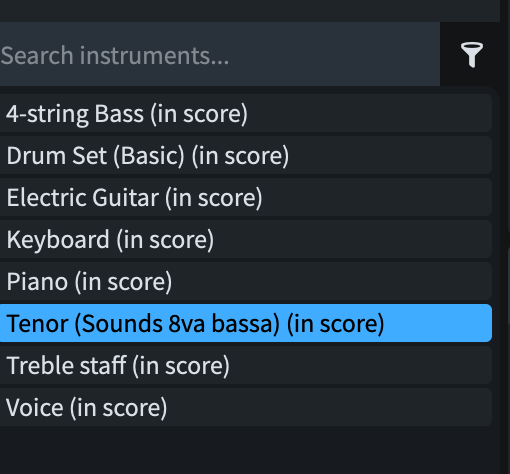Thanks Ben - if you go back and look at my first screenshot, that is without the “respect octaves” checked. That is how I want it to look. To me, the 8vb G clef should make Duncan sound a B2 and the regular G clef should make Vanessa sound B3. It is only with the “respect octaves” check that I get the second screenshot appearance.
I’m just using a keyboard sound for playback, so no worries about strange sounds. But for my singers to learn the music I want the playback to be in their exact vocal range.
Then you want to lower Duncan’s notes by an octave.
When I lower Duncan’s notes by an octave, with “respect octaves” checked, then I get Dunan singing a B1 and Vanessa singing a B2.
Let’s take things step by step.
You’ve said that with “Respect Octaves” ON, you get this written notation:
Yes?
And when you play that back, both singers start at the same pitch. Yes?
If that is the case, then the playback matches the notation. Hurrah. Now you just need to make sure that this is the notation that you want your singers to sing.
If Duncan is a high Tenor, knocking out Top Bs, then leave it as it is.
If not, stick the notation down an octave.
If Vanessa is a Mezzo, leave it as it is.
If she’s a high Soprano, stick the notation up an octave.
Your summary is correct. Duncan is a bari-tenor singing low in his range. Vanessa is an alto singing in her low medium range. So when I put the notation the way I want the singers to read it, the playback is an octave too low for both singers.
Seems like “respect ocatves” means something different to Dorico than it means to me. “Respect octaves” changes the appearance, but not the playback. If I “Ignore octaves” then I get the sound I want, but the appearance would be confusing for the singers (Vanessa needs to know to sing low in her range).
Then his notes need to be written down an octave than you have them.
Respect Octaves means that the octave clefs affect the pitch of the notes. So when you use the G8 clef, the notes are played one octave lower than they are written.
Here’s a sample file showing you how it should work.
If you want to upload a sample file that shows the relevant passage, then I can take a look at it.
Clefs.dorico (629.2 KB)
One more reply and then I need to call it a day. With “respect octaves” selected:
and notation looking like this:

The result is playback which is an octave too low (B1 for Duncan where it should be B2, B2 for Vanessa when it should be B3)
Then upload a sample document. It could be an octave offset in the Playback VST, for all we know.
As said, just provide the relevant passage; or PM me a copy if you don’t want to post it.
Thanks for having a look -
(attachments)
Animal Spirits NYC template - Genie In A Bottle.dorico (2.53 MB)
Your 2nd “Vocals” Player is still using a Tenor instrument, so everything is transposing down an octave. (You can see that if you move the music to the 1st Vocals staff, playback and notation are at the same pitch.)
Change the instrument to something else. (You’ll then need to change the sample to Electric Piano again.)
Or move the notes to the upper Vocals staff; raise the pitches by an octave, and add the G8d clef at the start.
This is exactly why Dorico’s octave clefs initially did not include any octave shift: Because some of the digital instruments already have the octave built in.
Now, when you activate Dorico’s option to respect the 8 in the clef, you also have to change the instrument - either use an instrument that does not include the octave shift (making it 2 octaves in sum), or adjust some knob in the virtual instrument to compensate for the octave shift.
OK, and should I do that using “edit instrument definition” or “change instrument”? They bring me to different dialog boxes.
Change instrument.


